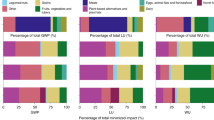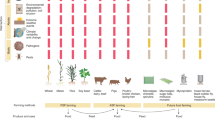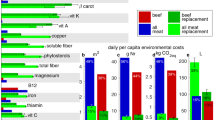Abstract
Altering diets is increasingly acknowledged as an important solution to feed the world’s growing population within the planetary boundaries. In our search for a planet-friendly diet, the main focus has been on eating more plant-source foods, and eating no or less animal-source foods, while the potential of future foods, such as insects, seaweed or cultured meat has been underexplored. Here we show that compared to current animal-source foods, future foods have major environmental benefits while safeguarding the intake of essential micronutrients. The complete array of essential nutrients in the mixture of future foods makes them good-quality alternatives for current animal-source foods compared to plant-source foods. Moreover, future foods are land-efficient alternatives for animal-source foods, and if produced with renewable energy, they also offer greenhouse gas benefits. Further research on nutrient bioavailability and digestibility, food safety, production costs and consumer acceptance will determine their role as main food sources in future diets.
This is a preview of subscription content, access via your institution
Access options
Access Nature and 54 other Nature Portfolio journals
Get Nature+, our best-value online-access subscription
$29.99 / 30 days
cancel any time
Subscribe to this journal
Receive 12 digital issues and online access to articles
$119.00 per year
only $9.92 per issue
Buy this article
- Purchase on Springer Link
- Instant access to full article PDF
Prices may be subject to local taxes which are calculated during checkout




Similar content being viewed by others
Data availability
The data supporting the findings of this study are available in this paper and its Supplementary Information.
References
Van Huis, A. et al. Edible Insects. Future Prospects for Food and Feed Security (FAO, 2013).
Post, M. J. Cultured beef: medical technology to produce food. J. Sci. Food Agric. 94, 1039–1041 (2014).
Wells, M. L. et al. Algae as nutritional and functional food sources: revisiting our understanding. J. Appl. Phycol. 29, 949–982 (2016).
FAOSTAT (FAO, 2017); http://www.fao.org/faostat/.
Van Zanten, H. H. E. et al. Defining a land boundary for sustainable livestock consumption. Glob. Change Biol. 24, 4185–4194 (2018).
Herrero, M. et al. Farming and the geography of nutrient production for human use: a transdisciplinary analysis. Lancet Planet. Health 1, e33–e42 (2017).
Wang, X. et al. Red and processed meat consumption and mortality: dose–response meta-analysis of prospective cohort studies. Public Health Nutr. 19, 893–905 (2016).
Pan, A. et al. Red meat consumption and mortality: results from 2 prospective cohort studies. Arch. Intern. Med. 172, 555–563 (2012).
Gerber, P. et al. Tackling Climate Change through Livestock. A Global Assessment of Emissions and Mitigation Opportunities (FAO, 2013).
Leip, A. et al. Impacts of European livestock production: nitrogen, sulphur, phosphorus and greenhouse gas emissions, land-use, water eutrophication and biodiversity. Environ. Res. Lett. 10, 115004 (2015).
Mottet, A. et al. Livestock: on our plates or eating at our table? A new analysis of the feed/food debate. Glob. Food Sec. 14, 1–8 (2017).
Alexandratos, N. & Bruinsma, J. World Agriculture towards 2030/2050: The 2012 Revision (FAO, 2012).
Alexander, P. et al. Could consumption of insects, cultured meat or imitation meat reduce global agricultural land use? Glob. Food Sec. 15, 22–32 (2017).
Low, J. W. et al. A food-based approach introducing orange-fleshed sweet potatoes increased vitamin A intake and serum retinol concentrations in young children in rural Mozambique. J. Nutr. 137, 1320–1327 (2007).
Pawlak, R., Lester, S. E. & Babatunde, T. The prevalence of cobalamin deficiency among vegetarians assessed by serum vitamin B12: a review of literature. Eur. J. Clin. Nutr. 68, 541–548 (2014).
Gladyshev, M. I., Sushchik, N. N. & Makhutova, O. N. Production of EPA and DHA in aquatic ecosystems and their transfer to the land. Prostaglandins Other Lipid Mediat. 107, 117–126 (2013).
Kainz, M., Arts, M. T. & Mazumder, A. Essential fatty acids in the planktonic food web and their ecological role for higher trophic levels. Limnol. Oceanogr. 49, 1784–1793 (2004).
Hixson, S. M. et al. Long-chain omega-3 polyunsaturated fatty acids have developmental effects on the crop pest, the cabbage white butterfly Pieris rapae. PLoS ONE 11, e0152264 (2016).
Liland, N. S. et al. Modulation of nutrient composition of black soldier fly (Hermetia illucens) larvae by feeding seaweed-enriched media. PLoS ONE 12, e0183188 (2017).
Hussein, M. et al. Sustainable production of housefly (Musca domestica) larvae as a protein-rich feed ingredient by utilizing cattle manure. PLoS ONE 12, e0171708 (2017).
Heck, V., Hoff, H., Wirsenius, S., Meyer, C. & Kreft, H. Land use options for staying within the Planetary Boundaries — synergies and trade-offs between global and local sustainability goals. Glob. Environ. Change 49, 73–84 (2018).
Tuomisto, H. L. & Teixeira de MattosM. J. Environmental impacts of cultured meat production. Environ. Sci. Technol. 45, 6117–6123 (2011).
Tuomisto, H. L., Ellis, M. J. & Haastrup, P. Environmental impacts of cultured meat: alternative production scenarios. In Proc. 9th International Conference on Life Cycle Assessment in the Agri-Food Sector 1360–1366 (LCA Food, 2014).
van Zanten, H. H. E. et al. From environmental nuisance to environmental opportunity: housefly larvae convert waste to livestock feed. J. Clean. Prod. 102, 362–369 (2015).
Salomone, R. et al. Environmental impact of food waste bioconversion by insects: application of life cycle assessment to process using Hermetia illucens. J. Clean. Prod. 140, 890–905 (2017).
Aubin, J., Fontaine, C., Callier, M. & Roque d’orbcastel, E. Blue mussel (Mytilus edulis) bouchot culture in Mont-St Michel Bay: potential mitigation effects on climate change and eutrophication. Int. J. Life Cycle Assess. 23, 1030–1041 (2018).
Hasselström, L., Visch, W., Gröndahl, F., Nylund, G. M. & Pavia, H. The impact of seaweed cultivation on ecosystem services — a case study from the west coast of Sweden. Mar. Pollut. Bull. 133, 53–64 (2018).
Lhafi, S. K. & Kühne, M. Occurrence of Vibrio spp. in blue mussels (Mytilus edulis) from the German Wadden Sea. Int. J. Food Microbiol. 116, 297–300 (2007).
Ziegler, F. et al. Expanding the concept of sustainable seafood using life cycle assessment. Fish Fish. 17, 1073–1093 (2016).
Henriksson, P. J. G., Belton, B., Jahan, K. M. & Rico, A. Measuring the potential for sustainable intensification of aquaculture in Bangladesh using life cycle assessment. Proc. Natl Acad. Sci. USA 115, 2958–2963 (2018).
Wiebe, M. G. QuornTM myco-protein - overview of a successful fungal product. Mycologist 18, 17–20 (2004).
Smetana, S., Palanisamy, M., Mathys, A. & Heinz, V. Sustainability of insect use for feed and food: life cycle assessment perspective. J. Clean. Prod. 137, 741–751 (2016).
Oonincx, D. G. A. B. et al. An exploration on greenhouse gas and ammonia production by insect species suitable for animal or human consumption. PLoS ONE 5, e14445 (2010).
Ray, N. E., O’Meara, T., Wiliamson, T., Izursa, J.-L. & Kangas, P. C. Consideration of carbon dioxide release during shell production in LCA of bivalves. Int. J. Life Cycle Assess. 23, 1042–1048 (2018).
Ramos-Elorduy, J. Insects: a sustainable source of food? Ecol. Food Nutr. 36, 247–276 (1997).
Yang, Q. et al. Nutritional composition and protein quality of the edible beetle Holotrichia parallela. J. Insect Sci. 14, 139 (2014).
Marono, S. et al. Crude protein digestibility of Tenebrio molitor and Hermetia illucens insect meals and its correlation with chemical composition traits. Ital. J. Anim. Sci. 14, 3889 (2015).
Latunde-Dada, G. O., Yang, W. & Aviles, M. V. In vitro iron availability from insects and sirloin beef. Agric. Food Chem. 66, 8420–8424 (2016).
Fleurence, J. L., Morançais, M. & Dumay, M. in Proteins in Food Processing 2nd edn (ed. Yada, R. Y.) 245–262 (Woodhead Publishing, Cambridge, 2018).
Edwards, D. G. & Cummings, J. H. The protein quality of mycoprotein. Proc. Nutr. Soc. 69, E331 (2010).
Mišurcová, L., Kráčmar, S., Klekdus, B. & Vacek, J. Nitrogen content, dietary fiber, and digestibility in algal food products. Czech J. Food Sci. 28, 27–35 (2010).
Maehre, H. K., Edvinsen, G. K., Eilertsen, K. E. & Elvevoll, E. O. Heat treatment increases the protein bioaccessibility in the red seaweed dulse (Palmaria palmata), but not in the brown seaweed winged kelp (Alaria esculenta). J. Appl. Phycol. 28, 581–590 (2016).
Kose, A., Ozen, M. O., Elibol, M. & Oncel, S. S. Investigation of in vitro digestibility of dietary microalga Chlorella vulgaris and cyanobacterium Spirulina platensis as a nutritional supplement. 3 Biotech 7, 170 (2017).
Selmi, C. et al. The effects of Spirulina on anemia and immune function in senior citizens. Cell. Mol. Immunol. 8, 248–254 (2011).
Nakano, S., Takekoshi, H. & Nakano, M. Chlorella pyrenoidosa supplementation reduces the risk of anemia, proteinuria and edema in pregnant women. Plant Foods Hum. Nutr. 65, 25–30 (2010).
Li, L. et al. Spirulina can increase total-body vitamin A stores of Chinese school-age children as determined by a paired isotope dilution technique. J. Nutr. Sci. 1, e19 (2012).
Watanabe, F. & Bito, T. Vitamin B12 sources and microbial interaction. Exp. Biol. Med. 243, 148–158 (2018).
Watanabe, F. et al. Pseudovitamin B12 is the predominant cobamide of an algal health food, Spirulina tablets. J. Agric. Food Chem. 47, 4736–4741 (1999).
Broekman, H. C. H. P. et al. Is mealworm or shrimp allergy indicative for food allergy to insects?. Mol. Nutr. Food Res. 61, 1601061 (2017).
Lüning, K. & Mortensen, L. European aquaculture of sugar kelp (Saccharina latissima) for food industries: iodine content and epiphytic animals as major problems. Bot. Mar. 58, 449–455 (2015).
Ursu, A.-V. et al. Extraction, fractionation and functional properties of proteins from the microalgae Chlorella vulgaris. Bioresour. Technol. 157, 134–139 (2014).
Bußler, S., Rumpold, B. A., Jander, E., Rawel, H. M. & Schlüter, O. K. Recovery and techno-functionality of flours and proteins from two edible insect species: meal worm (Tenebrio molitor) and black soldier fly (Hermetia illucens) larvae. Heliyon 2, e00218 (2016).
Oonincx, D. G. A. B. & de Boer, I. J. M. Environmental impact of the production of mealworms as a protein source for humans — a life cycle assessment. PLoS ONE 7, e51145 (2012).
Oonincx, D. G. A. B., van Broekhoven, S., van Huis, A. & van Loon, J. J. A. Feed conversion, survival and development, and composition of four insect species on diets composed of food by-products. PLoS ONE 10, e0144601 (2015).
van Zanten, H. H. E., Mollenhorst, H., Bikker, P., Herrero, M. & de Boer, I. J. M. Opinion paper: the role of livestock in a sustainable diet: a land-use perspective. Animal 10, 547–549 (2016).
Post, M. J. Cultured meat from stem cells: challenges and prospects. Meat Sci. 92, 297–301 (2012).
The State of World Fisheries and Aquaculture 2016. Contributing to Food Security and Nutrition for All (FAO, 2016).
USDA Food Composition Databases (USDA, 2017); https://ndb.nal.usda.gov/ndb/.
Post, M. J. in Proteins Food Processing 2nd edn (ed. Yada, R. Y.) 289–298 (Woodhead Publishing, Cambridge, 2018).
Moll, R. & Davis, B. Iron, vitamin B12 and folate. Medicine 45, 198–203 (2017).
Jenkins, T. C., Wallace, R. J., Moate, P. J. & Mosley, E. E. Board-invited review: recent advances in biohydrogenation of unsaturated fatty acids within the rumen microbial ecosystem. J. Anim. Sci. 86, 397–412 (2008).
Leip, A., Weiss, F., Lesschen, J. P. & Westhoek, H. The nitrogen footprint of food products in the European Union. J. Agric. Sci. 152, 20–33 (2014).
Weiss, F. & Leip, A. Greenhouse gas emissions from the EU livestock sector: a life cycle assessment carried out with the CAPRI model. Agric. Ecosyst. Environ. 149, 124–134 (2012).
Leip, A. et al. Evaluation of the Livestock Sector’s Contribution to the EU Greenhouse Gas Emissions (GGELS) - Final Report (JRC, 2010).
Codex Alimentarius. Guidelines on Nutrition Labelling (FAO & WHO, 1985).
EFSA Panel on Dietetic Products, Nutrition, and Allergies (NDA) Scientific opinion on dietary reference values for fats, including saturated fatty acids, polyunsaturated fatty acids, monounsaturated fatty acids, trans fatty acids, and cholesterol. European Food Safety Authority. EFSA J. 8, 1461 (2010).
Acknowledgements
This paper constitutes an output of the Expert Panel of Nitrogen and Food of the Task Force on Reactive Nitrogen under the Working Group on Strategies and Review of the UNECE Convention on Long-range Transboundary Air Pollution. The research leading to these results has received funding from the European Union’s Horizon 2020 Programme under Grant Agreement number 633692 (SUSFANS).
Author information
Authors and Affiliations
Contributions
A.L. and H.H.E.V.Z. designed the research. A.P. and H.H.E.V.Z. conceived and led the project, reviewed the literature, analysed the data and wrote the paper. The following authors analysed the data and edited the paper: A.L., I.J.M.D.B., C.E.V.M., M.H. and H.V. analysed data on environmental impacts, P.M.S. analysed data on microalgae, F.Z. analysed data on seafood and mussels, E.H.M.T. analysed data on nutrition, H.T. analysed data on cultured meat and J.J.A.V.L. analysed data on insects.
Corresponding author
Ethics declarations
Competing interests
The authors declare no competing interests.
Additional information
Publisher’s note: Springer Nature remains neutral with regard to jurisdictional claims in published maps and institutional affiliations.
Supplementary information
Supplementary Information
Supplementary Figures 1–7, Supplementary Methods, Supplementary Discussion, Supplementary References
Supplementary Dataset 1
8 Supplementary Tables
Rights and permissions
About this article
Cite this article
Parodi, A., Leip, A., De Boer, I.J.M. et al. The potential of future foods for sustainable and healthy diets. Nat Sustain 1, 782–789 (2018). https://doi.org/10.1038/s41893-018-0189-7
Received:
Accepted:
Published:
Issue Date:
DOI: https://doi.org/10.1038/s41893-018-0189-7
This article is cited by
-
Feeding the future global population
Nature Communications (2024)
-
Novel Drying Technologies for Future Animal- and Plant-Derived Protein Foods: Research Progress, Challenges, and Potential Applications
Food and Bioprocess Technology (2024)
-
Low-opportunity-cost feed can reduce land-use-related environmental impacts by about one-third in China
Nature Food (2023)
-
Low-carbon diets can reduce global ecological and health costs
Nature Food (2023)
-
Immunomodulatory activity of semen Ziziphi Spinosae protein: a potential plant protein functional food raw material
npj Science of Food (2023)



